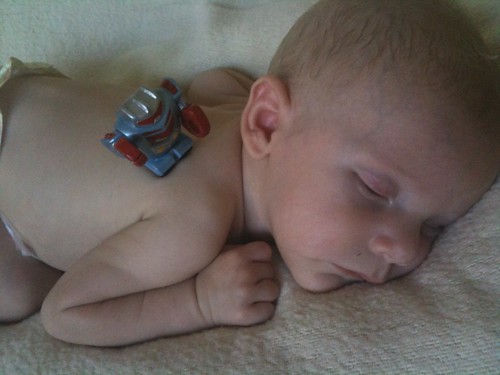The Complicated Ethics of the Unborn
1.
The first thing I think about when I think about the rights of the unborn is the odious fight against a woman's right to choose. To whit, Mississippi's recently failed Initiative 26 which tried to grant full rights to a fertilized egg. Let's call that the sledgehammer approach.Then there is the scalpel approach, such as Canada's proposed Unborn Victims of Crime Act or the US's (enacted) Unborn Victims of Violence Act. These and other acts that try to restrict access to abortion pick at grey areas and blurry lines. The Unborn Victims acts in particular attempt to codify the intuition that harming a pregnant woman is worse than harming a regular person.In all cases, the arguments against tend to centre around the (perhaps) unintended far-reaching consequences of the bill.
 photo credit: Michael Connell
photo credit: Michael Connell
2.
A different class of the unborn in often invoked in envrionmentalist ethics. This is all the rhetoric of the "we didn't inherit the earth, we are borrowing it from our grandchildren" variety. This is at the heart of sustainability. Practices which increase the amount of future we have are sustainable. Practices which reduce it are not. But what should I care about the future? I won't be around to see most of it. Ah yes, but we owe it to future generations. How much do we owe them?This is a very real and practical problem. How much should we discount or value the future? Economists are grappling with it as we speak. Deciding on the answer guides how hard we must work to prevent bringing future generations to harm.
3.
The sustainable health of the planet and the suffering of post-born animals are two big reasons to be a vegetarian or vegan. One of the strange consequences of choosing a diet that reduces your consumption of meat is that it reduces the demand for meat which implies that it should reduce the number of certain kinds of animal being born. A completely vegan society would wipe out whole species of domesticated animal. There would be no reason to breed them, so they would stop being born.To what extent is this an issue for ethics? Bear in mind that some segments of society invest a great deal of effort into ensuring that there are future generations of other animals, such as pandas.
4.
Ducks Unlimited seeks to preserve wetlands and waterfowl population, primarily so that their membership has something to shoot at.
5.
Another strategy for reducing the suffering of post-born animals is to grow meat without animals at an industrial scale. The In Vitro Meat Consortium makes an explicit argument on this point.
 photo credit: James Nash (aka Cirrus)
photo credit: James Nash (aka Cirrus)
6.
Now we have a third class of unborn. The vat-grown. The cloned.Human cloning, (non-bindingly banned by the UN) has proven especially troubling, ethically. The bans are fascinating, because they are effectively saying "we don't know how to unravel the ethics of human cloning, so please don't confront us with the problem".
7.
Some fertility treatments have a tendency to fertilize too many eggs, resulting in too many conceptions. In a lot of cases these extra fetuses are aborted. The grassroots group Parents Against MS 26 who helped bring down Initiative 26 was started by a woman who had benefitted from such a treatment and who feared that declaring fertilized eggs as persons would make it impossible for other women to benefit from similar treatments.
 photo credit: Jenn and Tony Bot
photo credit: Jenn and Tony Bot
8.
One of the most frustrating narrative tropes in science fiction is the singular artificial intelligence. When they have AI in the story, there's only ever one, and it's always precious, and so can be stopped by shutting down the mainframe or whatever (2001 gets a pass on this because the were out in the middle of spac e and it's implied that there are more HALs back on earth).The thing that computers do better than anything else is copy things. As soon as you get one AI, you get as many as you want. More than you want, probably. As soon as you shut one down, it's just a matter of booting from the backup. How would you even tell the edges of each personality?Maybe the first AIs will look like this most recent hypothesis of what The Last Unique Common Ancestor
Researchers at the University of Illinois, believe the last universal common ancestor, or LUCA, was actually a single organism that lived about three billion years ago. This organism was unlike anything we've ever seen, and was basically an amorphous conglomeration of cells.Instead of competing for resources and developing into separate lifeforms, cells spent hundreds of millions of years freely exchanging genetic material with each other, which allowed species to obtain the tools to survive without ever having to compete for anything. That's maybe not an organism as we would comprehend it today, but that's the closest term we have for this cooperative arrangement.
Alasdair Wilkins The ancestor of all life on Earth might have been a gigantic planetary super-organism on io9
9.
AI are our fourth class of unborn.While full blown human-like AI isn't in the near future, AI with various other levels of intelligence and personality certainly is. How smart or how animal-like does an AI system have to get before we start according it rights?
 photo credit: Ѕolo
photo credit: Ѕolo
10.
I enjoyed Kyle Munkittrick's article arguing that Pixar is paving the road for cohabitation between sentient humans and non-humans.
The relationship between humans and the non-human characters is critical to understanding Pixar’s movies. There are certain rules in Pixar movies that make things far more interesting than the average Disney fairy tale. The first is that there is no magic. No problems are caused or fixed by the wave of a wand. Second, every Pixar film happens in the world of human beings (see why I excluded Cars? It’s ridiculous and out of character for Pixar). Even in films like a A Bug’s Life and Finding Nemo, in which humans only exist as backdrops for the action, humanity’s presence in the story is essential. The first two rules are pretty direct: the universe Pixar’s characters inhabit is non-magical and co-inhabited by humans.The third rule is that at least one main character is an intelligent being that isn’t a human. This rule is a bit complex, so let’s flesh it out. There are two types human roles in Pixar films. The first is Human as Villain. In films like the Toy Story 1, 2, & 3, A Bug’s Life, and Finding Nemo, the protagonists are all non-human. Ancillary characters like Sid, the Collector, and Darla are not main characters. A more accurate description would be that they are pieces of the environment and, on occasion, playing the role of supporting antagonist. The second type of Pixar film is Human as Partner. In these films, the main character befriends a human being as part of the hero’s journey: Remy, Colette, and Linguini; WALL-E, EVE, Mary and John; Sully, Mike, and Boo; Russell, Carl, Kevin and Dug. These are the heroic teams of their respective films.In each Pixar film, at least one member of the team is human and at least one member is not human but possesses human levels of intelligence.You can see where I’m going here. Particularly in WALL•E, Ratatouille and Up! there is no ambiguity about the reality of intelligence in the non-human characters. Each Pixar film asks us to accept one deviation from our reality. While it seems like the deviation is different in every case (e.g. monsters are real, robots can fall in love, fish have a sense of family, Kevin is a girl, a rat can cook), the simple fact is that Pixar only asks us to accept one idea over and over and over again:Non-humans are sentient beings. That is the central difference between Pixar’s universe and our current reality.That idea alone would suffice to show that Pixar films are all but propaganda for the concept of non-human personhood. But that is where the hidden message begins.
Kyle Munkittrick The Hidden Message in Pixar’s Films for Discover
11.
I think it's interesting that, rhetorically, right of centre politics seems to prefer to emphasize the rights of the individual unborn while acting against the interests of unborn generations while the left of centre tends act in favour of the interests of unborn generations while resisting the rights of unborn individuals.So far, no one has a coherent stance on robots and clones.
 photo credit: Alan / Falcon
photo credit: Alan / Falcon